Woolworths Supermarket Supply Chain Management Analysis Report
VerifiedAdded on 2022/08/18
|13
|2772
|17
Report
AI Summary
This report presents a comprehensive analysis of Woolworths' supply chain management, focusing on its value chain and sustainability initiatives. The report begins with an overview of Woolworths, an Australian retailing giant, and its operational divisions. It then delves into the company's supply chain management practices, highlighting its use of Trade-Stone’s Merchandise Lifecycle Management platform to connect with suppliers and manage its extensive retail network. The report analyzes Woolworths' value chain, examining both primary activities such as operations, inbound and outbound logistics, marketing and sales, and after-sales services, and secondary activities including procurement, technological development, and human resource management. The analysis emphasizes Woolworths' commitment to sustainability, including efforts to reduce freight expenses and implement safety standards. The report also discusses the linkage between Woolworths' activities and supply chain management theories. In conclusion, the report underscores Woolworths' effective supply chain strategies. This assignment is available on Desklib, a platform providing study tools for students.
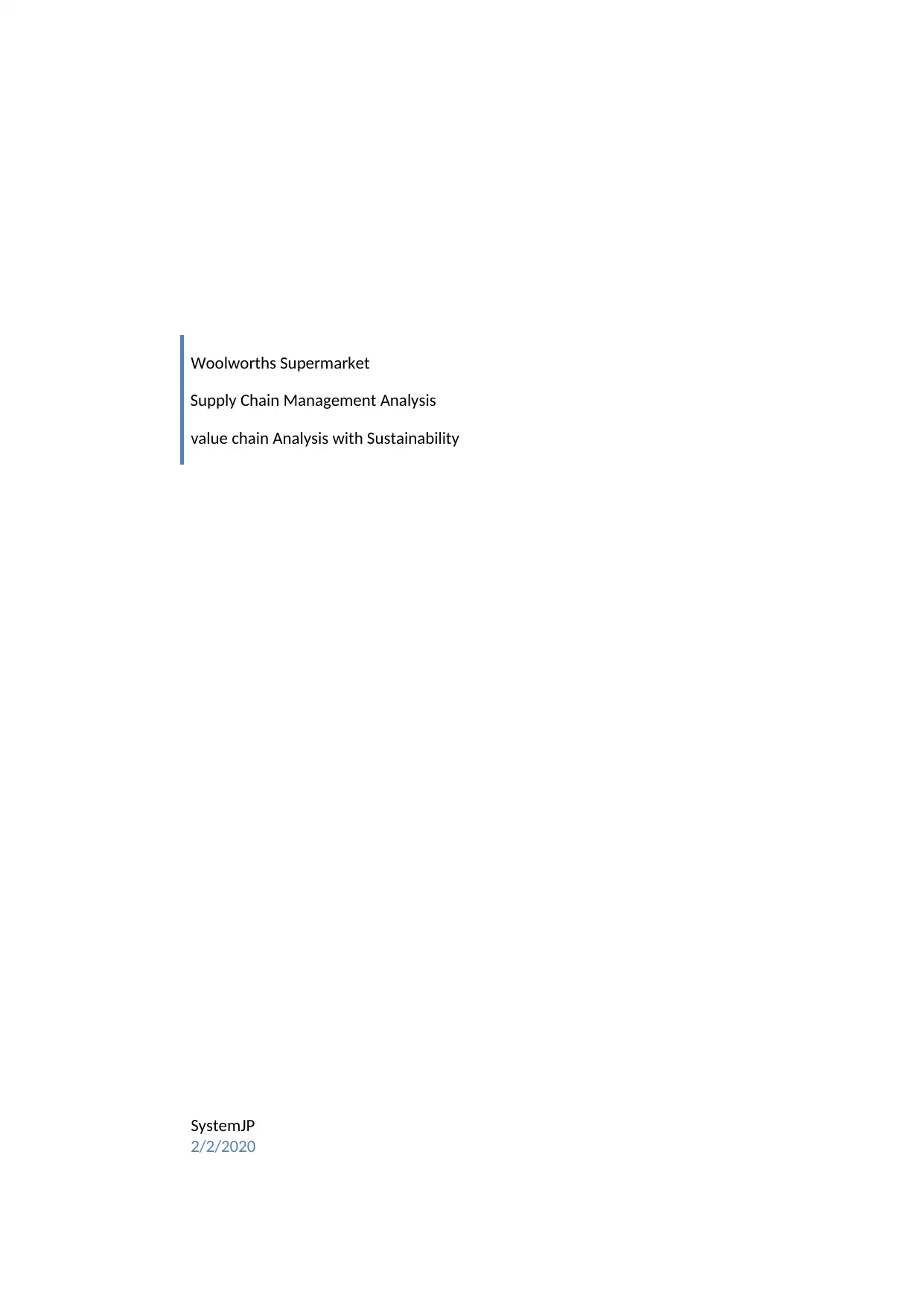
Woolworths Supermarket
Supply Chain Management Analysis
value chain Analysis with Sustainability
SystemJP
2/2/2020
Supply Chain Management Analysis
value chain Analysis with Sustainability
SystemJP
2/2/2020
Paraphrase This Document
Need a fresh take? Get an instant paraphrase of this document with our AI Paraphraser
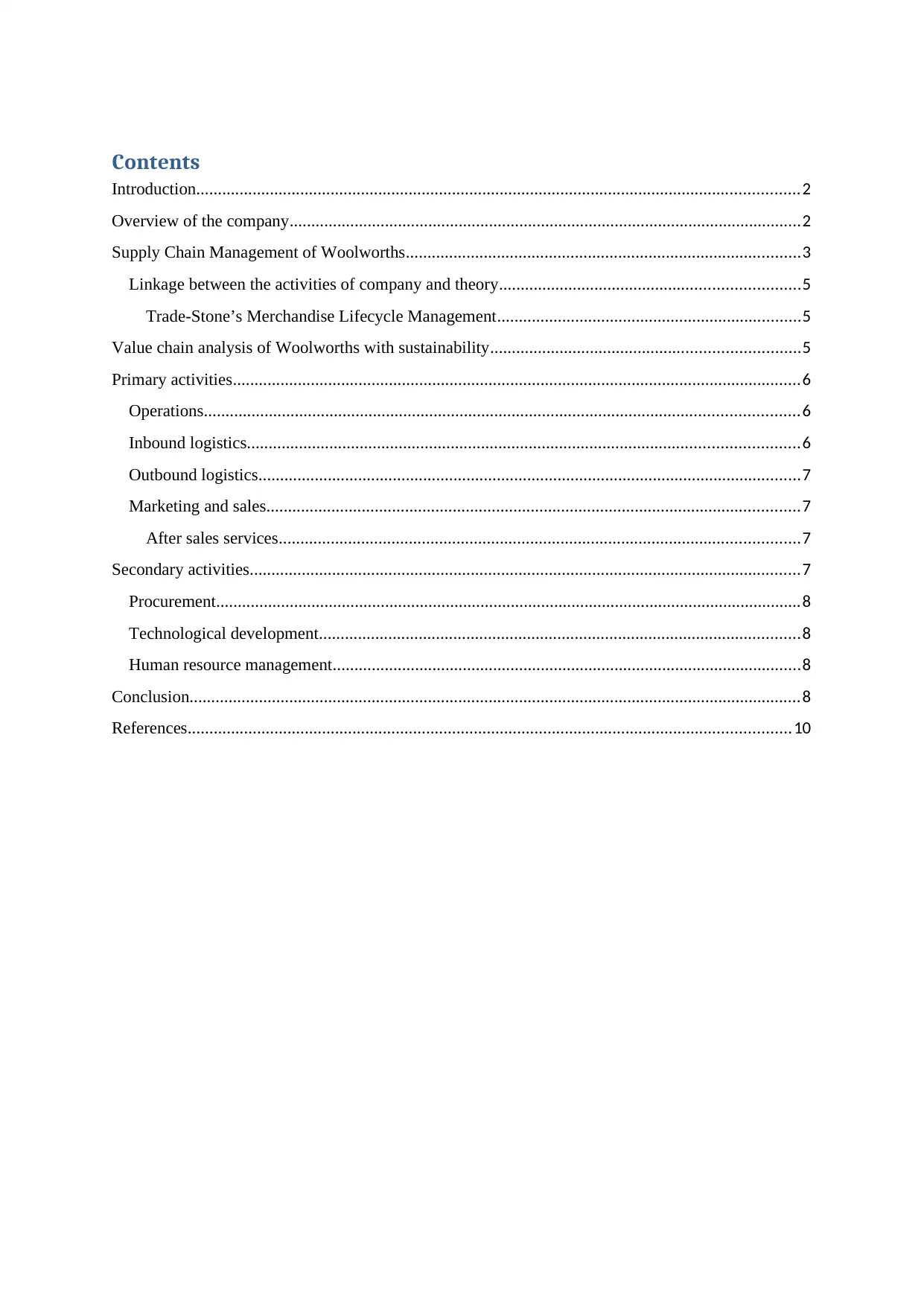
Contents
Introduction...........................................................................................................................................2
Overview of the company......................................................................................................................2
Supply Chain Management of Woolworths...........................................................................................3
Linkage between the activities of company and theory.....................................................................5
Trade-Stone’s Merchandise Lifecycle Management......................................................................5
Value chain analysis of Woolworths with sustainability.......................................................................5
Primary activities...................................................................................................................................6
Operations.........................................................................................................................................6
Inbound logistics...............................................................................................................................6
Outbound logistics.............................................................................................................................7
Marketing and sales...........................................................................................................................7
After sales services........................................................................................................................7
Secondary activities...............................................................................................................................7
Procurement.......................................................................................................................................8
Technological development...............................................................................................................8
Human resource management............................................................................................................8
Conclusion.............................................................................................................................................8
References...........................................................................................................................................10
Introduction...........................................................................................................................................2
Overview of the company......................................................................................................................2
Supply Chain Management of Woolworths...........................................................................................3
Linkage between the activities of company and theory.....................................................................5
Trade-Stone’s Merchandise Lifecycle Management......................................................................5
Value chain analysis of Woolworths with sustainability.......................................................................5
Primary activities...................................................................................................................................6
Operations.........................................................................................................................................6
Inbound logistics...............................................................................................................................6
Outbound logistics.............................................................................................................................7
Marketing and sales...........................................................................................................................7
After sales services........................................................................................................................7
Secondary activities...............................................................................................................................7
Procurement.......................................................................................................................................8
Technological development...............................................................................................................8
Human resource management............................................................................................................8
Conclusion.............................................................................................................................................8
References...........................................................................................................................................10
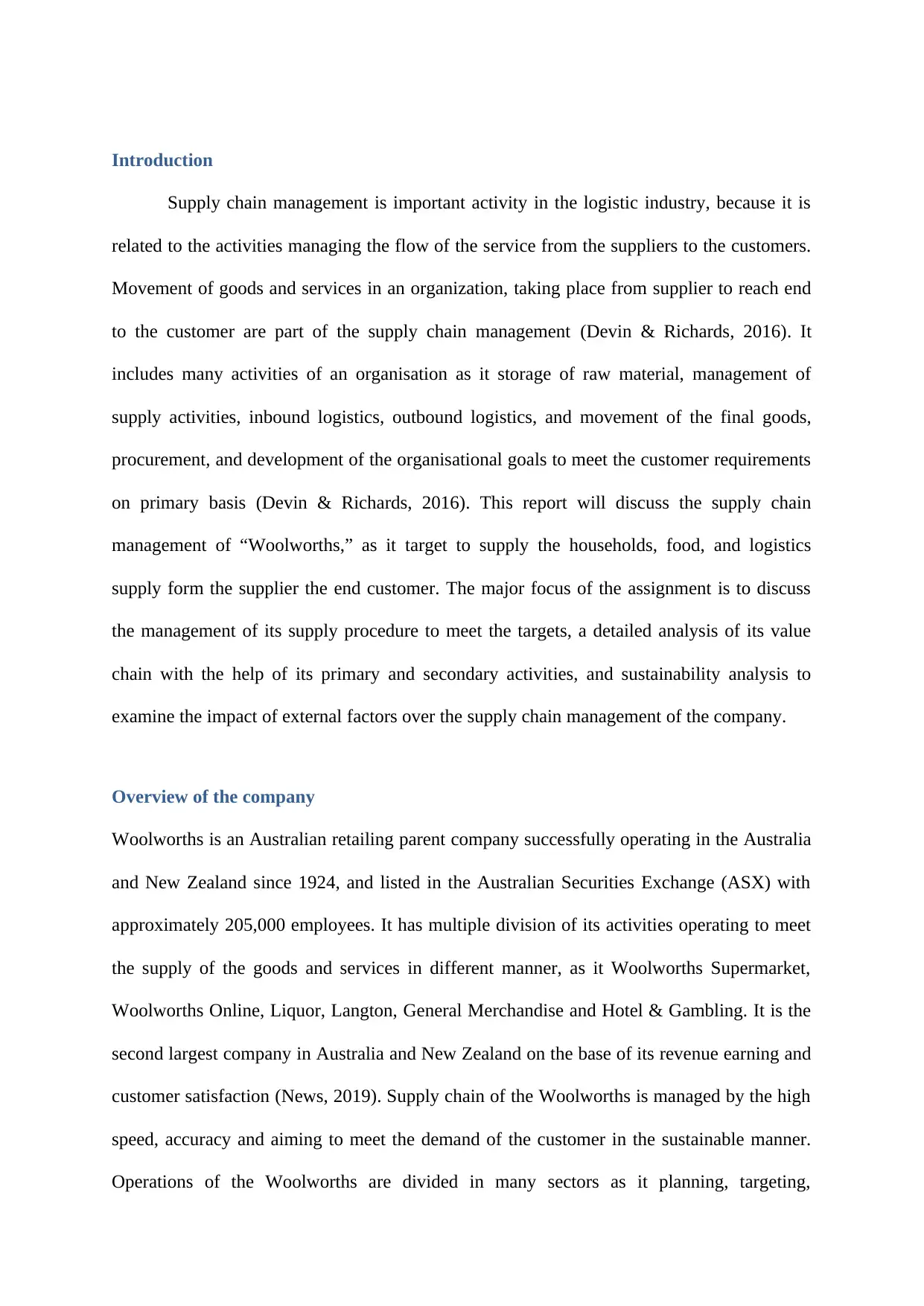
Introduction
Supply chain management is important activity in the logistic industry, because it is
related to the activities managing the flow of the service from the suppliers to the customers.
Movement of goods and services in an organization, taking place from supplier to reach end
to the customer are part of the supply chain management (Devin & Richards, 2016). It
includes many activities of an organisation as it storage of raw material, management of
supply activities, inbound logistics, outbound logistics, and movement of the final goods,
procurement, and development of the organisational goals to meet the customer requirements
on primary basis (Devin & Richards, 2016). This report will discuss the supply chain
management of “Woolworths,” as it target to supply the households, food, and logistics
supply form the supplier the end customer. The major focus of the assignment is to discuss
the management of its supply procedure to meet the targets, a detailed analysis of its value
chain with the help of its primary and secondary activities, and sustainability analysis to
examine the impact of external factors over the supply chain management of the company.
Overview of the company
Woolworths is an Australian retailing parent company successfully operating in the Australia
and New Zealand since 1924, and listed in the Australian Securities Exchange (ASX) with
approximately 205,000 employees. It has multiple division of its activities operating to meet
the supply of the goods and services in different manner, as it Woolworths Supermarket,
Woolworths Online, Liquor, Langton, General Merchandise and Hotel & Gambling. It is the
second largest company in Australia and New Zealand on the base of its revenue earning and
customer satisfaction (News, 2019). Supply chain of the Woolworths is managed by the high
speed, accuracy and aiming to meet the demand of the customer in the sustainable manner.
Operations of the Woolworths are divided in many sectors as it planning, targeting,
Supply chain management is important activity in the logistic industry, because it is
related to the activities managing the flow of the service from the suppliers to the customers.
Movement of goods and services in an organization, taking place from supplier to reach end
to the customer are part of the supply chain management (Devin & Richards, 2016). It
includes many activities of an organisation as it storage of raw material, management of
supply activities, inbound logistics, outbound logistics, and movement of the final goods,
procurement, and development of the organisational goals to meet the customer requirements
on primary basis (Devin & Richards, 2016). This report will discuss the supply chain
management of “Woolworths,” as it target to supply the households, food, and logistics
supply form the supplier the end customer. The major focus of the assignment is to discuss
the management of its supply procedure to meet the targets, a detailed analysis of its value
chain with the help of its primary and secondary activities, and sustainability analysis to
examine the impact of external factors over the supply chain management of the company.
Overview of the company
Woolworths is an Australian retailing parent company successfully operating in the Australia
and New Zealand since 1924, and listed in the Australian Securities Exchange (ASX) with
approximately 205,000 employees. It has multiple division of its activities operating to meet
the supply of the goods and services in different manner, as it Woolworths Supermarket,
Woolworths Online, Liquor, Langton, General Merchandise and Hotel & Gambling. It is the
second largest company in Australia and New Zealand on the base of its revenue earning and
customer satisfaction (News, 2019). Supply chain of the Woolworths is managed by the high
speed, accuracy and aiming to meet the demand of the customer in the sustainable manner.
Operations of the Woolworths are divided in many sectors as it planning, targeting,
⊘ This is a preview!⊘
Do you want full access?
Subscribe today to unlock all pages.

Trusted by 1+ million students worldwide
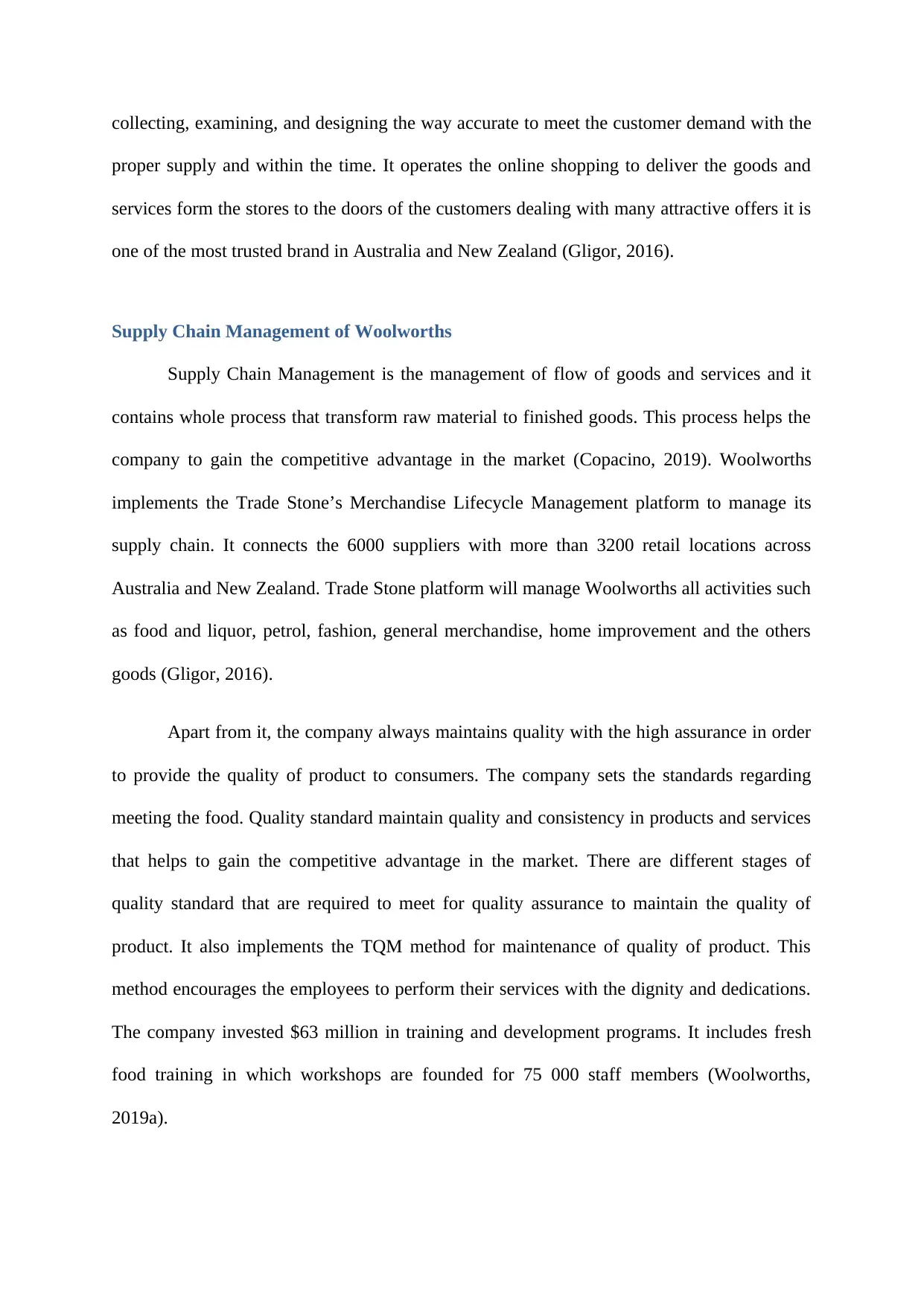
collecting, examining, and designing the way accurate to meet the customer demand with the
proper supply and within the time. It operates the online shopping to deliver the goods and
services form the stores to the doors of the customers dealing with many attractive offers it is
one of the most trusted brand in Australia and New Zealand (Gligor, 2016).
Supply Chain Management of Woolworths
Supply Chain Management is the management of flow of goods and services and it
contains whole process that transform raw material to finished goods. This process helps the
company to gain the competitive advantage in the market (Copacino, 2019). Woolworths
implements the Trade Stone’s Merchandise Lifecycle Management platform to manage its
supply chain. It connects the 6000 suppliers with more than 3200 retail locations across
Australia and New Zealand. Trade Stone platform will manage Woolworths all activities such
as food and liquor, petrol, fashion, general merchandise, home improvement and the others
goods (Gligor, 2016).
Apart from it, the company always maintains quality with the high assurance in order
to provide the quality of product to consumers. The company sets the standards regarding
meeting the food. Quality standard maintain quality and consistency in products and services
that helps to gain the competitive advantage in the market. There are different stages of
quality standard that are required to meet for quality assurance to maintain the quality of
product. It also implements the TQM method for maintenance of quality of product. This
method encourages the employees to perform their services with the dignity and dedications.
The company invested $63 million in training and development programs. It includes fresh
food training in which workshops are founded for 75 000 staff members (Woolworths,
2019a).
proper supply and within the time. It operates the online shopping to deliver the goods and
services form the stores to the doors of the customers dealing with many attractive offers it is
one of the most trusted brand in Australia and New Zealand (Gligor, 2016).
Supply Chain Management of Woolworths
Supply Chain Management is the management of flow of goods and services and it
contains whole process that transform raw material to finished goods. This process helps the
company to gain the competitive advantage in the market (Copacino, 2019). Woolworths
implements the Trade Stone’s Merchandise Lifecycle Management platform to manage its
supply chain. It connects the 6000 suppliers with more than 3200 retail locations across
Australia and New Zealand. Trade Stone platform will manage Woolworths all activities such
as food and liquor, petrol, fashion, general merchandise, home improvement and the others
goods (Gligor, 2016).
Apart from it, the company always maintains quality with the high assurance in order
to provide the quality of product to consumers. The company sets the standards regarding
meeting the food. Quality standard maintain quality and consistency in products and services
that helps to gain the competitive advantage in the market. There are different stages of
quality standard that are required to meet for quality assurance to maintain the quality of
product. It also implements the TQM method for maintenance of quality of product. This
method encourages the employees to perform their services with the dignity and dedications.
The company invested $63 million in training and development programs. It includes fresh
food training in which workshops are founded for 75 000 staff members (Woolworths,
2019a).
Paraphrase This Document
Need a fresh take? Get an instant paraphrase of this document with our AI Paraphraser
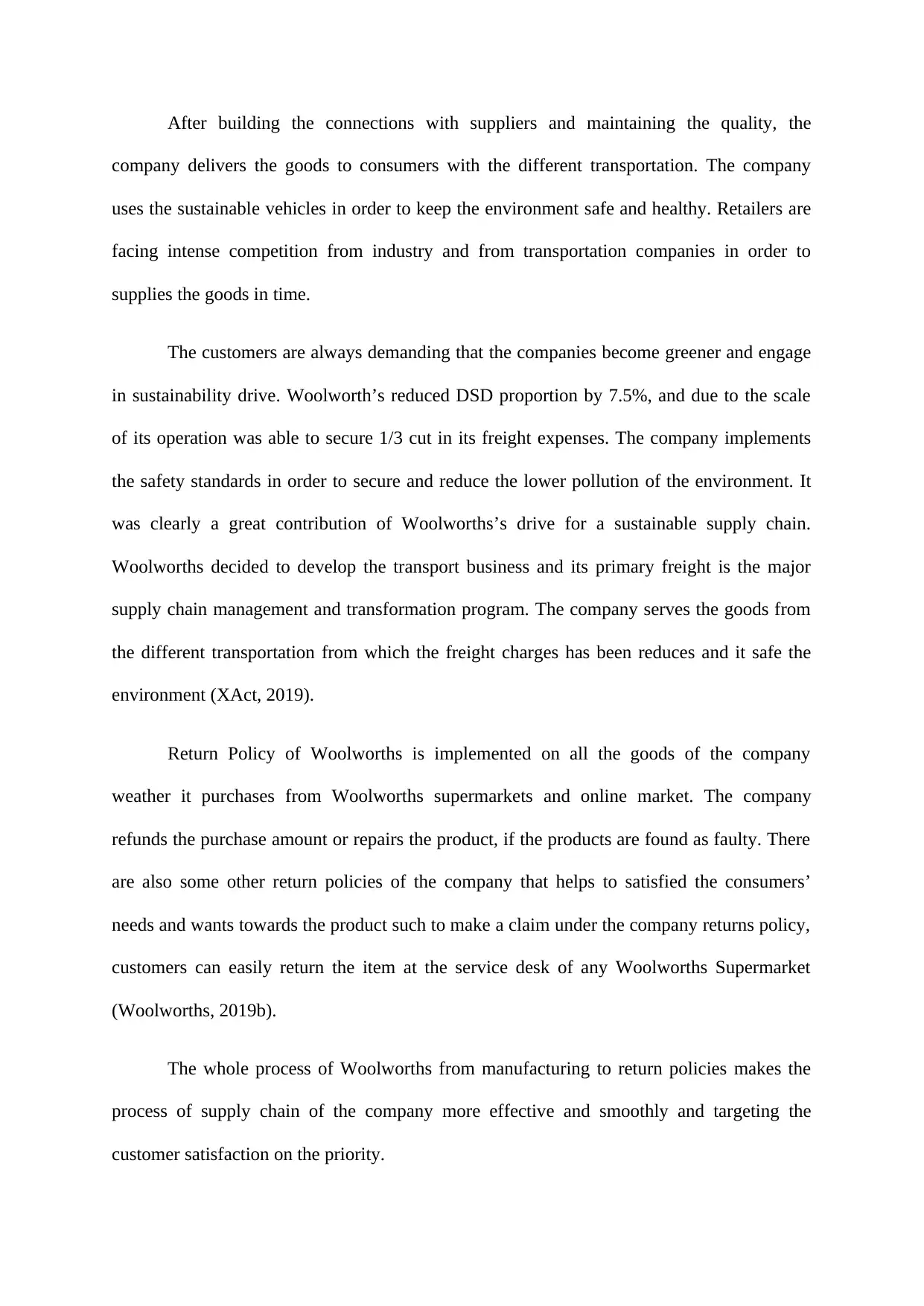
After building the connections with suppliers and maintaining the quality, the
company delivers the goods to consumers with the different transportation. The company
uses the sustainable vehicles in order to keep the environment safe and healthy. Retailers are
facing intense competition from industry and from transportation companies in order to
supplies the goods in time.
The customers are always demanding that the companies become greener and engage
in sustainability drive. Woolworth’s reduced DSD proportion by 7.5%, and due to the scale
of its operation was able to secure 1/3 cut in its freight expenses. The company implements
the safety standards in order to secure and reduce the lower pollution of the environment. It
was clearly a great contribution of Woolworths’s drive for a sustainable supply chain.
Woolworths decided to develop the transport business and its primary freight is the major
supply chain management and transformation program. The company serves the goods from
the different transportation from which the freight charges has been reduces and it safe the
environment (XAct, 2019).
Return Policy of Woolworths is implemented on all the goods of the company
weather it purchases from Woolworths supermarkets and online market. The company
refunds the purchase amount or repairs the product, if the products are found as faulty. There
are also some other return policies of the company that helps to satisfied the consumers’
needs and wants towards the product such to make a claim under the company returns policy,
customers can easily return the item at the service desk of any Woolworths Supermarket
(Woolworths, 2019b).
The whole process of Woolworths from manufacturing to return policies makes the
process of supply chain of the company more effective and smoothly and targeting the
customer satisfaction on the priority.
company delivers the goods to consumers with the different transportation. The company
uses the sustainable vehicles in order to keep the environment safe and healthy. Retailers are
facing intense competition from industry and from transportation companies in order to
supplies the goods in time.
The customers are always demanding that the companies become greener and engage
in sustainability drive. Woolworth’s reduced DSD proportion by 7.5%, and due to the scale
of its operation was able to secure 1/3 cut in its freight expenses. The company implements
the safety standards in order to secure and reduce the lower pollution of the environment. It
was clearly a great contribution of Woolworths’s drive for a sustainable supply chain.
Woolworths decided to develop the transport business and its primary freight is the major
supply chain management and transformation program. The company serves the goods from
the different transportation from which the freight charges has been reduces and it safe the
environment (XAct, 2019).
Return Policy of Woolworths is implemented on all the goods of the company
weather it purchases from Woolworths supermarkets and online market. The company
refunds the purchase amount or repairs the product, if the products are found as faulty. There
are also some other return policies of the company that helps to satisfied the consumers’
needs and wants towards the product such to make a claim under the company returns policy,
customers can easily return the item at the service desk of any Woolworths Supermarket
(Woolworths, 2019b).
The whole process of Woolworths from manufacturing to return policies makes the
process of supply chain of the company more effective and smoothly and targeting the
customer satisfaction on the priority.
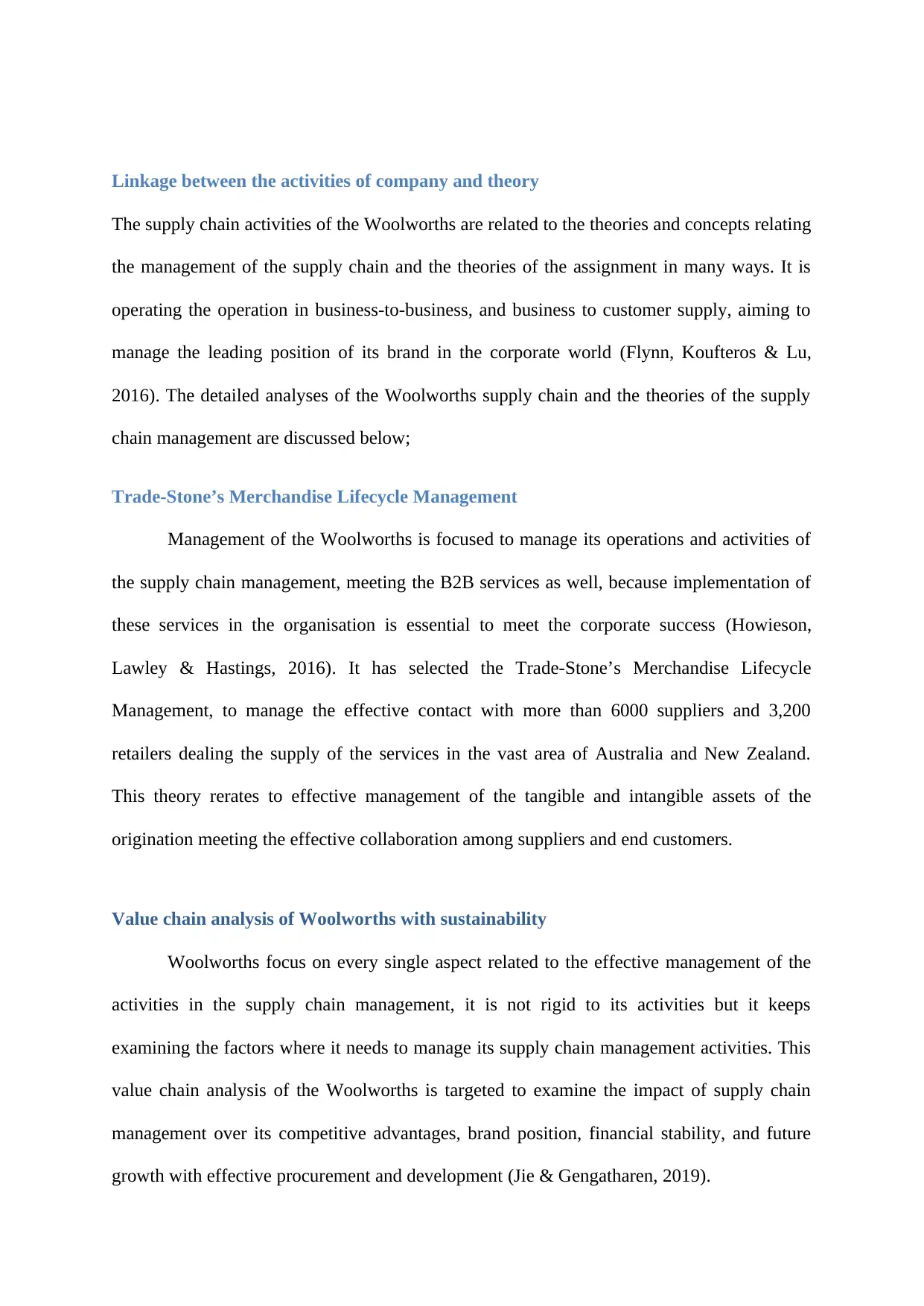
Linkage between the activities of company and theory
The supply chain activities of the Woolworths are related to the theories and concepts relating
the management of the supply chain and the theories of the assignment in many ways. It is
operating the operation in business-to-business, and business to customer supply, aiming to
manage the leading position of its brand in the corporate world (Flynn, Koufteros & Lu,
2016). The detailed analyses of the Woolworths supply chain and the theories of the supply
chain management are discussed below;
Trade-Stone’s Merchandise Lifecycle Management
Management of the Woolworths is focused to manage its operations and activities of
the supply chain management, meeting the B2B services as well, because implementation of
these services in the organisation is essential to meet the corporate success (Howieson,
Lawley & Hastings, 2016). It has selected the Trade-Stone’s Merchandise Lifecycle
Management, to manage the effective contact with more than 6000 suppliers and 3,200
retailers dealing the supply of the services in the vast area of Australia and New Zealand.
This theory rerates to effective management of the tangible and intangible assets of the
origination meeting the effective collaboration among suppliers and end customers.
Value chain analysis of Woolworths with sustainability
Woolworths focus on every single aspect related to the effective management of the
activities in the supply chain management, it is not rigid to its activities but it keeps
examining the factors where it needs to manage its supply chain management activities. This
value chain analysis of the Woolworths is targeted to examine the impact of supply chain
management over its competitive advantages, brand position, financial stability, and future
growth with effective procurement and development (Jie & Gengatharen, 2019).
The supply chain activities of the Woolworths are related to the theories and concepts relating
the management of the supply chain and the theories of the assignment in many ways. It is
operating the operation in business-to-business, and business to customer supply, aiming to
manage the leading position of its brand in the corporate world (Flynn, Koufteros & Lu,
2016). The detailed analyses of the Woolworths supply chain and the theories of the supply
chain management are discussed below;
Trade-Stone’s Merchandise Lifecycle Management
Management of the Woolworths is focused to manage its operations and activities of
the supply chain management, meeting the B2B services as well, because implementation of
these services in the organisation is essential to meet the corporate success (Howieson,
Lawley & Hastings, 2016). It has selected the Trade-Stone’s Merchandise Lifecycle
Management, to manage the effective contact with more than 6000 suppliers and 3,200
retailers dealing the supply of the services in the vast area of Australia and New Zealand.
This theory rerates to effective management of the tangible and intangible assets of the
origination meeting the effective collaboration among suppliers and end customers.
Value chain analysis of Woolworths with sustainability
Woolworths focus on every single aspect related to the effective management of the
activities in the supply chain management, it is not rigid to its activities but it keeps
examining the factors where it needs to manage its supply chain management activities. This
value chain analysis of the Woolworths is targeted to examine the impact of supply chain
management over its competitive advantages, brand position, financial stability, and future
growth with effective procurement and development (Jie & Gengatharen, 2019).
⊘ This is a preview!⊘
Do you want full access?
Subscribe today to unlock all pages.

Trusted by 1+ million students worldwide
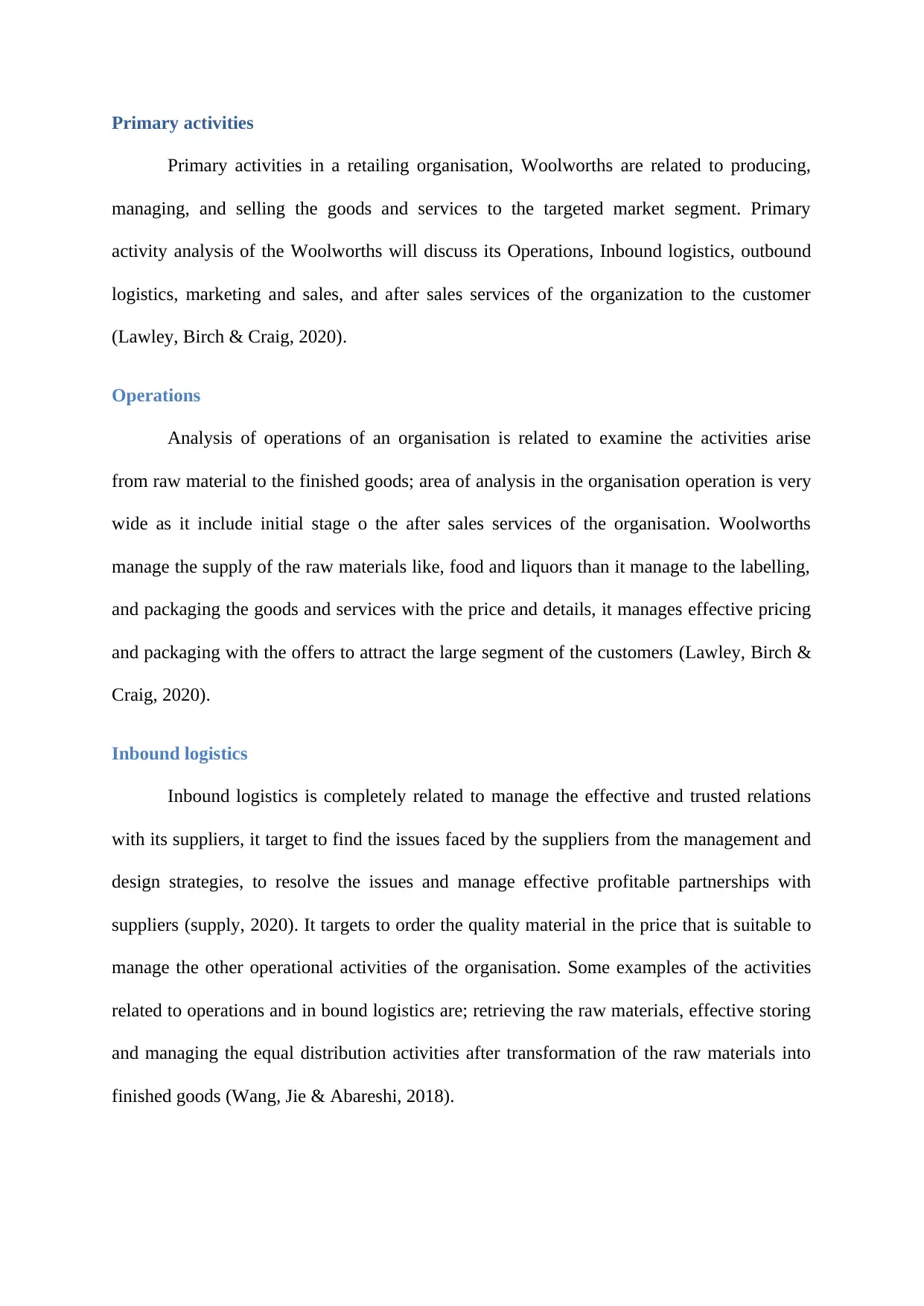
Primary activities
Primary activities in a retailing organisation, Woolworths are related to producing,
managing, and selling the goods and services to the targeted market segment. Primary
activity analysis of the Woolworths will discuss its Operations, Inbound logistics, outbound
logistics, marketing and sales, and after sales services of the organization to the customer
(Lawley, Birch & Craig, 2020).
Operations
Analysis of operations of an organisation is related to examine the activities arise
from raw material to the finished goods; area of analysis in the organisation operation is very
wide as it include initial stage o the after sales services of the organisation. Woolworths
manage the supply of the raw materials like, food and liquors than it manage to the labelling,
and packaging the goods and services with the price and details, it manages effective pricing
and packaging with the offers to attract the large segment of the customers (Lawley, Birch &
Craig, 2020).
Inbound logistics
Inbound logistics is completely related to manage the effective and trusted relations
with its suppliers, it target to find the issues faced by the suppliers from the management and
design strategies, to resolve the issues and manage effective profitable partnerships with
suppliers (supply, 2020). It targets to order the quality material in the price that is suitable to
manage the other operational activities of the organisation. Some examples of the activities
related to operations and in bound logistics are; retrieving the raw materials, effective storing
and managing the equal distribution activities after transformation of the raw materials into
finished goods (Wang, Jie & Abareshi, 2018).
Primary activities in a retailing organisation, Woolworths are related to producing,
managing, and selling the goods and services to the targeted market segment. Primary
activity analysis of the Woolworths will discuss its Operations, Inbound logistics, outbound
logistics, marketing and sales, and after sales services of the organization to the customer
(Lawley, Birch & Craig, 2020).
Operations
Analysis of operations of an organisation is related to examine the activities arise
from raw material to the finished goods; area of analysis in the organisation operation is very
wide as it include initial stage o the after sales services of the organisation. Woolworths
manage the supply of the raw materials like, food and liquors than it manage to the labelling,
and packaging the goods and services with the price and details, it manages effective pricing
and packaging with the offers to attract the large segment of the customers (Lawley, Birch &
Craig, 2020).
Inbound logistics
Inbound logistics is completely related to manage the effective and trusted relations
with its suppliers, it target to find the issues faced by the suppliers from the management and
design strategies, to resolve the issues and manage effective profitable partnerships with
suppliers (supply, 2020). It targets to order the quality material in the price that is suitable to
manage the other operational activities of the organisation. Some examples of the activities
related to operations and in bound logistics are; retrieving the raw materials, effective storing
and managing the equal distribution activities after transformation of the raw materials into
finished goods (Wang, Jie & Abareshi, 2018).
Paraphrase This Document
Need a fresh take? Get an instant paraphrase of this document with our AI Paraphraser
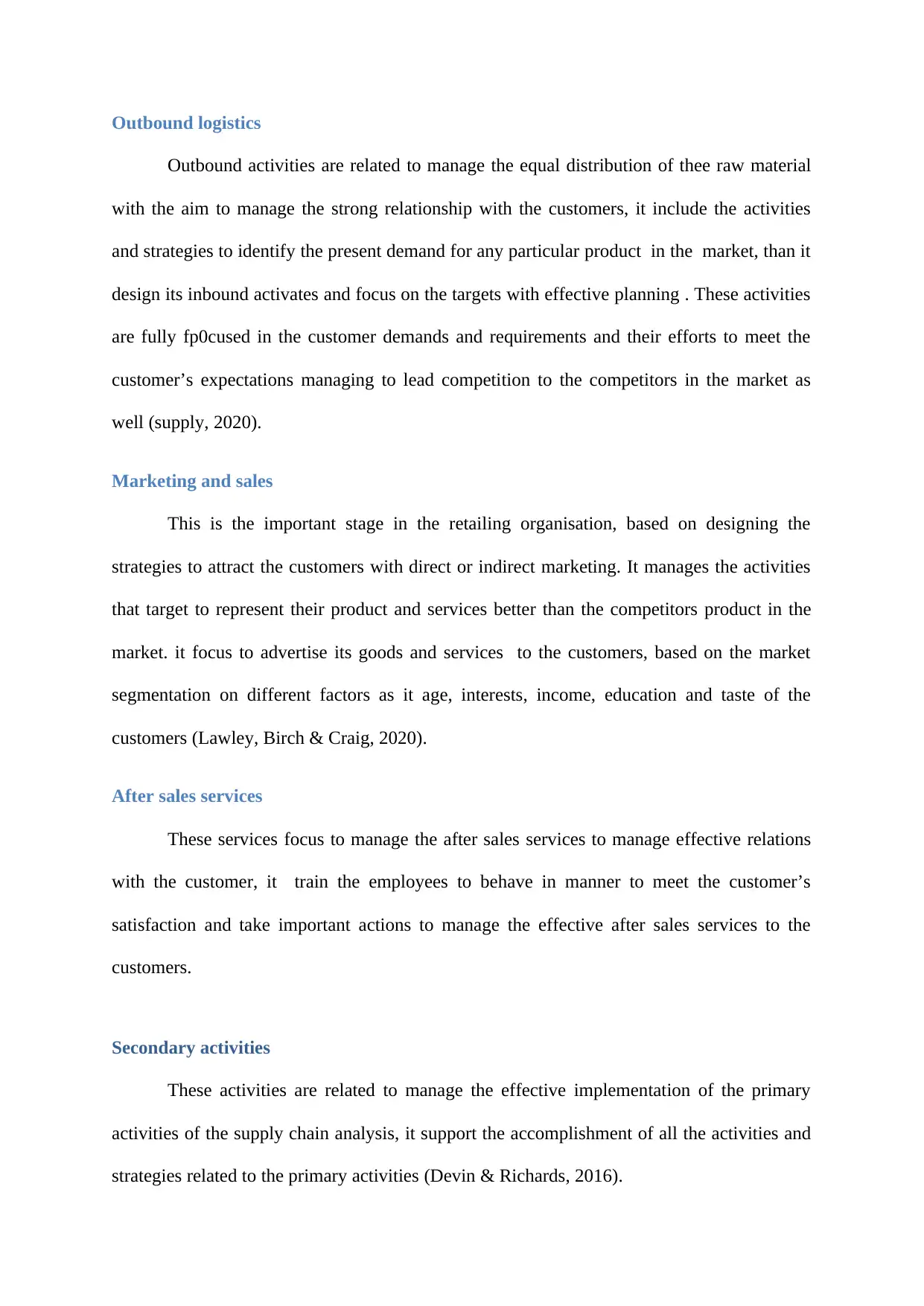
Outbound logistics
Outbound activities are related to manage the equal distribution of thee raw material
with the aim to manage the strong relationship with the customers, it include the activities
and strategies to identify the present demand for any particular product in the market, than it
design its inbound activates and focus on the targets with effective planning . These activities
are fully fp0cused in the customer demands and requirements and their efforts to meet the
customer’s expectations managing to lead competition to the competitors in the market as
well (supply, 2020).
Marketing and sales
This is the important stage in the retailing organisation, based on designing the
strategies to attract the customers with direct or indirect marketing. It manages the activities
that target to represent their product and services better than the competitors product in the
market. it focus to advertise its goods and services to the customers, based on the market
segmentation on different factors as it age, interests, income, education and taste of the
customers (Lawley, Birch & Craig, 2020).
After sales services
These services focus to manage the after sales services to manage effective relations
with the customer, it train the employees to behave in manner to meet the customer’s
satisfaction and take important actions to manage the effective after sales services to the
customers.
Secondary activities
These activities are related to manage the effective implementation of the primary
activities of the supply chain analysis, it support the accomplishment of all the activities and
strategies related to the primary activities (Devin & Richards, 2016).
Outbound activities are related to manage the equal distribution of thee raw material
with the aim to manage the strong relationship with the customers, it include the activities
and strategies to identify the present demand for any particular product in the market, than it
design its inbound activates and focus on the targets with effective planning . These activities
are fully fp0cused in the customer demands and requirements and their efforts to meet the
customer’s expectations managing to lead competition to the competitors in the market as
well (supply, 2020).
Marketing and sales
This is the important stage in the retailing organisation, based on designing the
strategies to attract the customers with direct or indirect marketing. It manages the activities
that target to represent their product and services better than the competitors product in the
market. it focus to advertise its goods and services to the customers, based on the market
segmentation on different factors as it age, interests, income, education and taste of the
customers (Lawley, Birch & Craig, 2020).
After sales services
These services focus to manage the after sales services to manage effective relations
with the customer, it train the employees to behave in manner to meet the customer’s
satisfaction and take important actions to manage the effective after sales services to the
customers.
Secondary activities
These activities are related to manage the effective implementation of the primary
activities of the supply chain analysis, it support the accomplishment of all the activities and
strategies related to the primary activities (Devin & Richards, 2016).
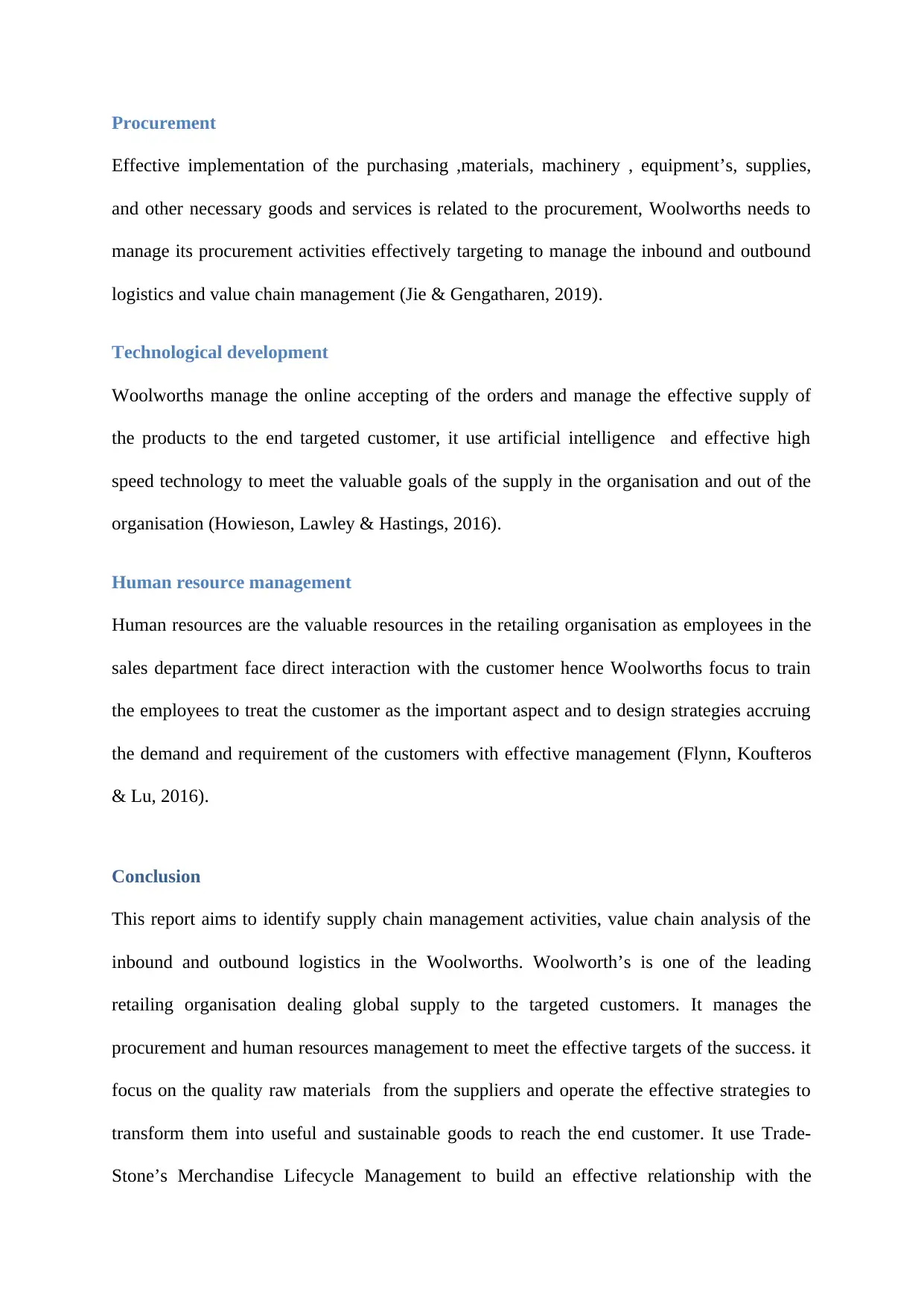
Procurement
Effective implementation of the purchasing ,materials, machinery , equipment’s, supplies,
and other necessary goods and services is related to the procurement, Woolworths needs to
manage its procurement activities effectively targeting to manage the inbound and outbound
logistics and value chain management (Jie & Gengatharen, 2019).
Technological development
Woolworths manage the online accepting of the orders and manage the effective supply of
the products to the end targeted customer, it use artificial intelligence and effective high
speed technology to meet the valuable goals of the supply in the organisation and out of the
organisation (Howieson, Lawley & Hastings, 2016).
Human resource management
Human resources are the valuable resources in the retailing organisation as employees in the
sales department face direct interaction with the customer hence Woolworths focus to train
the employees to treat the customer as the important aspect and to design strategies accruing
the demand and requirement of the customers with effective management (Flynn, Koufteros
& Lu, 2016).
Conclusion
This report aims to identify supply chain management activities, value chain analysis of the
inbound and outbound logistics in the Woolworths. Woolworth’s is one of the leading
retailing organisation dealing global supply to the targeted customers. It manages the
procurement and human resources management to meet the effective targets of the success. it
focus on the quality raw materials from the suppliers and operate the effective strategies to
transform them into useful and sustainable goods to reach the end customer. It use Trade-
Stone’s Merchandise Lifecycle Management to build an effective relationship with the
Effective implementation of the purchasing ,materials, machinery , equipment’s, supplies,
and other necessary goods and services is related to the procurement, Woolworths needs to
manage its procurement activities effectively targeting to manage the inbound and outbound
logistics and value chain management (Jie & Gengatharen, 2019).
Technological development
Woolworths manage the online accepting of the orders and manage the effective supply of
the products to the end targeted customer, it use artificial intelligence and effective high
speed technology to meet the valuable goals of the supply in the organisation and out of the
organisation (Howieson, Lawley & Hastings, 2016).
Human resource management
Human resources are the valuable resources in the retailing organisation as employees in the
sales department face direct interaction with the customer hence Woolworths focus to train
the employees to treat the customer as the important aspect and to design strategies accruing
the demand and requirement of the customers with effective management (Flynn, Koufteros
& Lu, 2016).
Conclusion
This report aims to identify supply chain management activities, value chain analysis of the
inbound and outbound logistics in the Woolworths. Woolworth’s is one of the leading
retailing organisation dealing global supply to the targeted customers. It manages the
procurement and human resources management to meet the effective targets of the success. it
focus on the quality raw materials from the suppliers and operate the effective strategies to
transform them into useful and sustainable goods to reach the end customer. It use Trade-
Stone’s Merchandise Lifecycle Management to build an effective relationship with the
⊘ This is a preview!⊘
Do you want full access?
Subscribe today to unlock all pages.

Trusted by 1+ million students worldwide
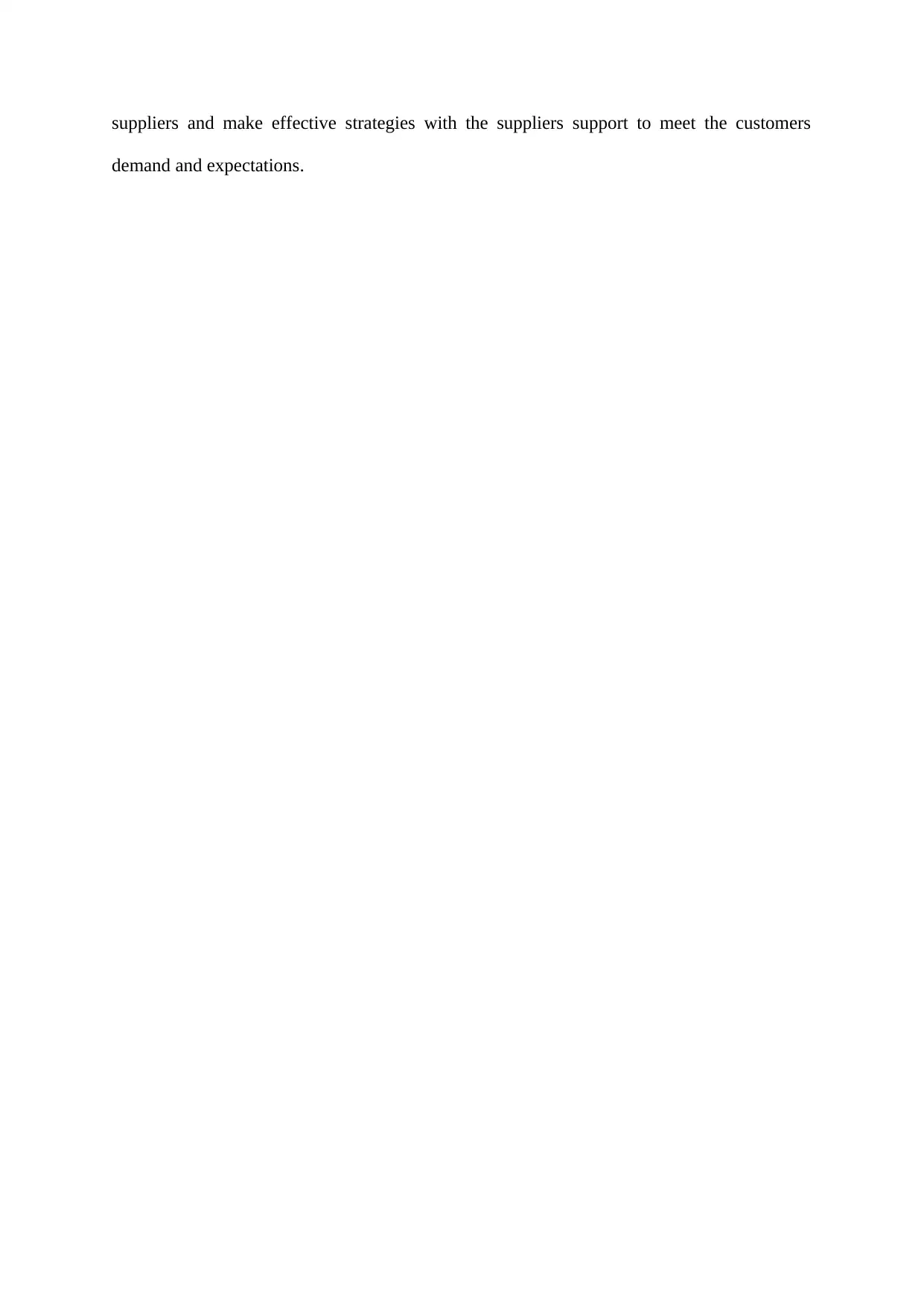
suppliers and make effective strategies with the suppliers support to meet the customers
demand and expectations.
demand and expectations.
Paraphrase This Document
Need a fresh take? Get an instant paraphrase of this document with our AI Paraphraser
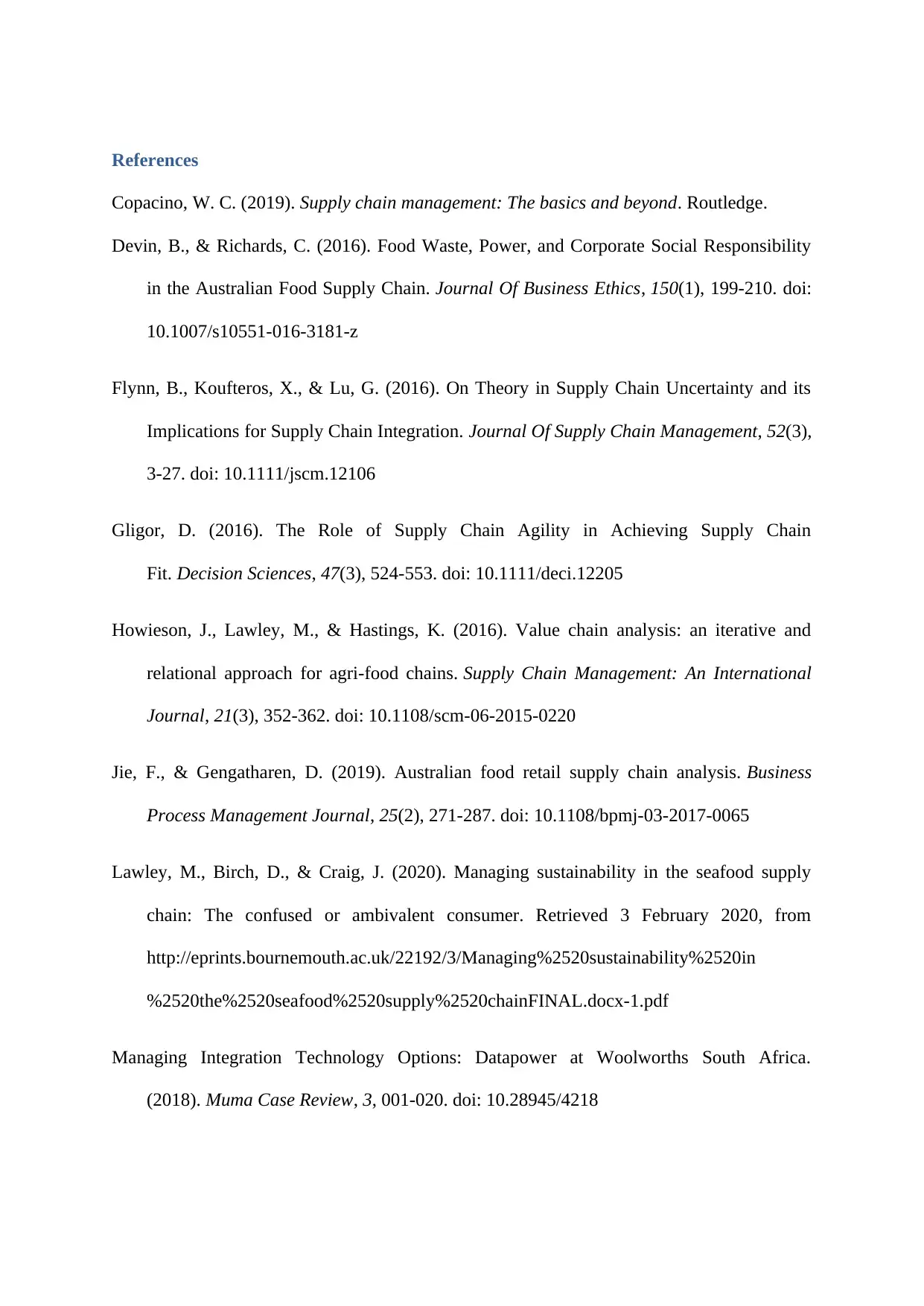
References
Copacino, W. C. (2019). Supply chain management: The basics and beyond. Routledge.
Devin, B., & Richards, C. (2016). Food Waste, Power, and Corporate Social Responsibility
in the Australian Food Supply Chain. Journal Of Business Ethics, 150(1), 199-210. doi:
10.1007/s10551-016-3181-z
Flynn, B., Koufteros, X., & Lu, G. (2016). On Theory in Supply Chain Uncertainty and its
Implications for Supply Chain Integration. Journal Of Supply Chain Management, 52(3),
3-27. doi: 10.1111/jscm.12106
Gligor, D. (2016). The Role of Supply Chain Agility in Achieving Supply Chain
Fit. Decision Sciences, 47(3), 524-553. doi: 10.1111/deci.12205
Howieson, J., Lawley, M., & Hastings, K. (2016). Value chain analysis: an iterative and
relational approach for agri-food chains. Supply Chain Management: An International
Journal, 21(3), 352-362. doi: 10.1108/scm-06-2015-0220
Jie, F., & Gengatharen, D. (2019). Australian food retail supply chain analysis. Business
Process Management Journal, 25(2), 271-287. doi: 10.1108/bpmj-03-2017-0065
Lawley, M., Birch, D., & Craig, J. (2020). Managing sustainability in the seafood supply
chain: The confused or ambivalent consumer. Retrieved 3 February 2020, from
http://eprints.bournemouth.ac.uk/22192/3/Managing%2520sustainability%2520in
%2520the%2520seafood%2520supply%2520chainFINAL.docx-1.pdf
Managing Integration Technology Options: Datapower at Woolworths South Africa.
(2018). Muma Case Review, 3, 001-020. doi: 10.28945/4218
Copacino, W. C. (2019). Supply chain management: The basics and beyond. Routledge.
Devin, B., & Richards, C. (2016). Food Waste, Power, and Corporate Social Responsibility
in the Australian Food Supply Chain. Journal Of Business Ethics, 150(1), 199-210. doi:
10.1007/s10551-016-3181-z
Flynn, B., Koufteros, X., & Lu, G. (2016). On Theory in Supply Chain Uncertainty and its
Implications for Supply Chain Integration. Journal Of Supply Chain Management, 52(3),
3-27. doi: 10.1111/jscm.12106
Gligor, D. (2016). The Role of Supply Chain Agility in Achieving Supply Chain
Fit. Decision Sciences, 47(3), 524-553. doi: 10.1111/deci.12205
Howieson, J., Lawley, M., & Hastings, K. (2016). Value chain analysis: an iterative and
relational approach for agri-food chains. Supply Chain Management: An International
Journal, 21(3), 352-362. doi: 10.1108/scm-06-2015-0220
Jie, F., & Gengatharen, D. (2019). Australian food retail supply chain analysis. Business
Process Management Journal, 25(2), 271-287. doi: 10.1108/bpmj-03-2017-0065
Lawley, M., Birch, D., & Craig, J. (2020). Managing sustainability in the seafood supply
chain: The confused or ambivalent consumer. Retrieved 3 February 2020, from
http://eprints.bournemouth.ac.uk/22192/3/Managing%2520sustainability%2520in
%2520the%2520seafood%2520supply%2520chainFINAL.docx-1.pdf
Managing Integration Technology Options: Datapower at Woolworths South Africa.
(2018). Muma Case Review, 3, 001-020. doi: 10.28945/4218
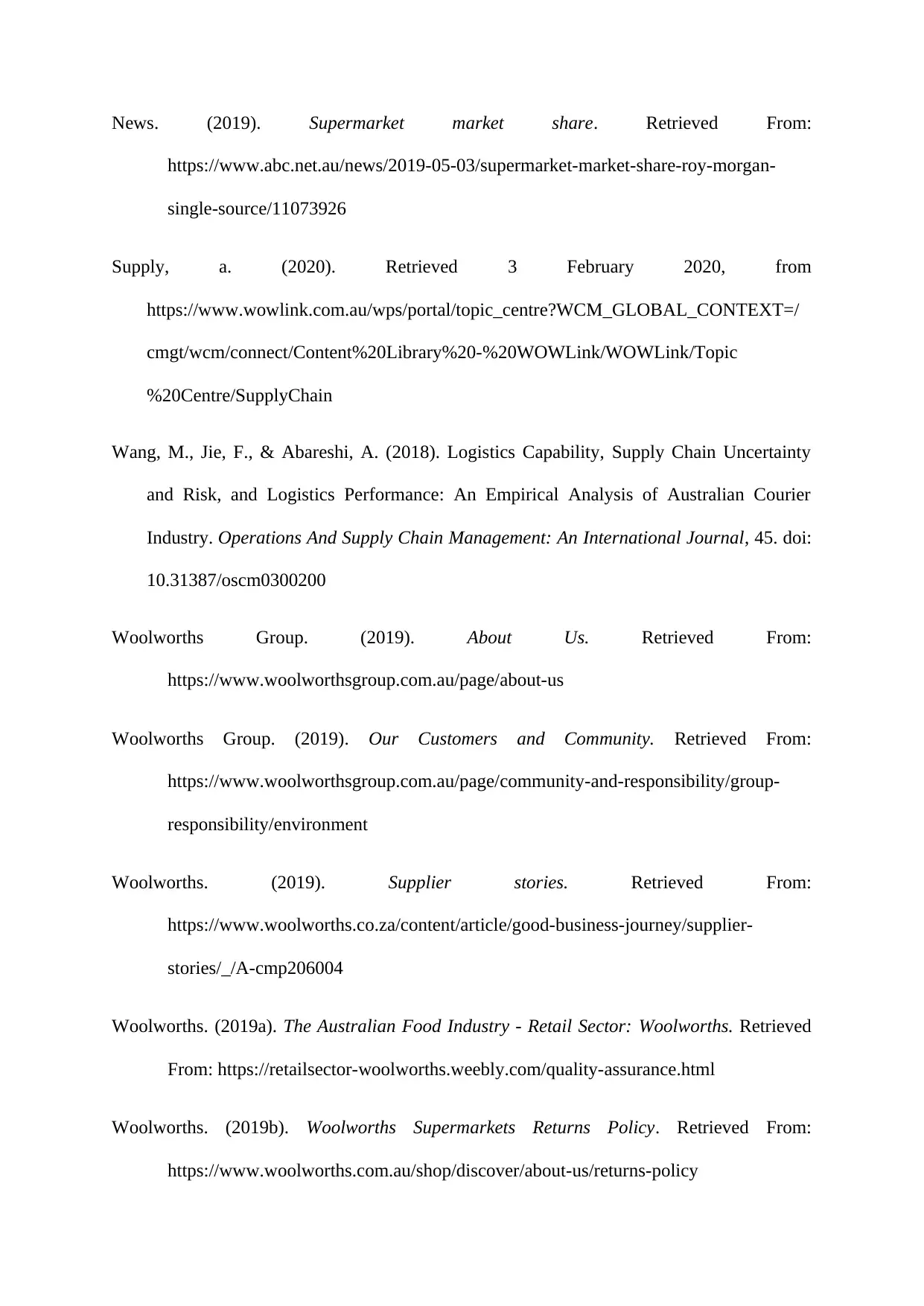
News. (2019). Supermarket market share. Retrieved From:
https://www.abc.net.au/news/2019-05-03/supermarket-market-share-roy-morgan-
single-source/11073926
Supply, a. (2020). Retrieved 3 February 2020, from
https://www.wowlink.com.au/wps/portal/topic_centre?WCM_GLOBAL_CONTEXT=/
cmgt/wcm/connect/Content%20Library%20-%20WOWLink/WOWLink/Topic
%20Centre/SupplyChain
Wang, M., Jie, F., & Abareshi, A. (2018). Logistics Capability, Supply Chain Uncertainty
and Risk, and Logistics Performance: An Empirical Analysis of Australian Courier
Industry. Operations And Supply Chain Management: An International Journal, 45. doi:
10.31387/oscm0300200
Woolworths Group. (2019). About Us. Retrieved From:
https://www.woolworthsgroup.com.au/page/about-us
Woolworths Group. (2019). Our Customers and Community. Retrieved From:
https://www.woolworthsgroup.com.au/page/community-and-responsibility/group-
responsibility/environment
Woolworths. (2019). Supplier stories. Retrieved From:
https://www.woolworths.co.za/content/article/good-business-journey/supplier-
stories/_/A-cmp206004
Woolworths. (2019a). The Australian Food Industry - Retail Sector: Woolworths. Retrieved
From: https://retailsector-woolworths.weebly.com/quality-assurance.html
Woolworths. (2019b). Woolworths Supermarkets Returns Policy. Retrieved From:
https://www.woolworths.com.au/shop/discover/about-us/returns-policy
https://www.abc.net.au/news/2019-05-03/supermarket-market-share-roy-morgan-
single-source/11073926
Supply, a. (2020). Retrieved 3 February 2020, from
https://www.wowlink.com.au/wps/portal/topic_centre?WCM_GLOBAL_CONTEXT=/
cmgt/wcm/connect/Content%20Library%20-%20WOWLink/WOWLink/Topic
%20Centre/SupplyChain
Wang, M., Jie, F., & Abareshi, A. (2018). Logistics Capability, Supply Chain Uncertainty
and Risk, and Logistics Performance: An Empirical Analysis of Australian Courier
Industry. Operations And Supply Chain Management: An International Journal, 45. doi:
10.31387/oscm0300200
Woolworths Group. (2019). About Us. Retrieved From:
https://www.woolworthsgroup.com.au/page/about-us
Woolworths Group. (2019). Our Customers and Community. Retrieved From:
https://www.woolworthsgroup.com.au/page/community-and-responsibility/group-
responsibility/environment
Woolworths. (2019). Supplier stories. Retrieved From:
https://www.woolworths.co.za/content/article/good-business-journey/supplier-
stories/_/A-cmp206004
Woolworths. (2019a). The Australian Food Industry - Retail Sector: Woolworths. Retrieved
From: https://retailsector-woolworths.weebly.com/quality-assurance.html
Woolworths. (2019b). Woolworths Supermarkets Returns Policy. Retrieved From:
https://www.woolworths.com.au/shop/discover/about-us/returns-policy
⊘ This is a preview!⊘
Do you want full access?
Subscribe today to unlock all pages.

Trusted by 1+ million students worldwide
1 out of 13
Related Documents
Your All-in-One AI-Powered Toolkit for Academic Success.
+13062052269
info@desklib.com
Available 24*7 on WhatsApp / Email
![[object Object]](/_next/static/media/star-bottom.7253800d.svg)
Unlock your academic potential
Copyright © 2020–2025 A2Z Services. All Rights Reserved. Developed and managed by ZUCOL.





